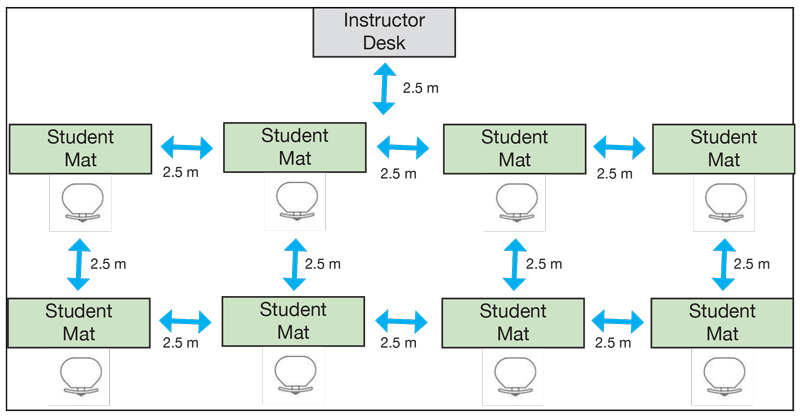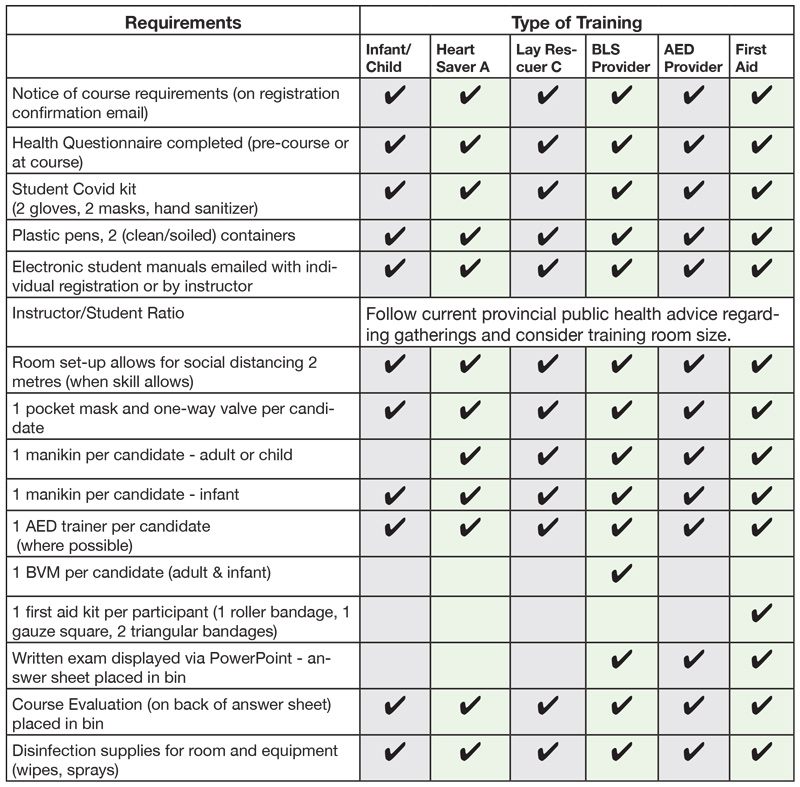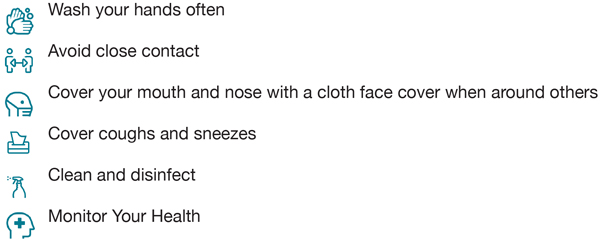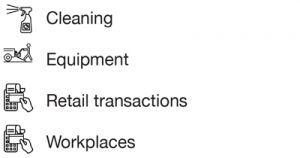Perri-Med First Aid and CPR Training Guidance on in-person classroom training during COVID-19
Update: June 20, 2020
During the COVID-19 (coronavirus) outbreak, we all need to do our part to keep instructors, customers and the public safe and healthy as we consider resuming in-class training. All instructors must follow all Provincial Government, Chief Medical Officer of Health and Ministry of Health guidelines for loosening restrictions for COVID-19 as they evolve. Instructors must only teach courses once they comply with all health and safety requirements, have sufficient health and safety supplies on hand, are prepared to teach (to meet all new guidelines) and feel comfortable enough to teach. Instructors do not have to teach at this time and may require addition time to purchase additional safety supplies, equipment and training materials. Do not feel pressured to have to resume training at this time. Following is a set of resources, tips and best practices to help instructors and customers prevent the spread of COVID-19.
Best Practices
Training providers and participants may be at risk of getting COVID-19 in training sessions where equipment is shared or where training happens in smaller indoor spaces, especially spaces that do not allow for physical distancing.
It is your responsibility to understand your municipal, provincial, and federal requirements and responsibilities as a business owner or sole proprietor or an employee delivering training as part of your employment.
The in-person classroom training provider should:
- Use a space that allows for physical distancing of at least 2 metres (6 feet)
- Have a plan in place for regular cleaning and sanitization
- Ensure personal hygiene can be maintained through access to running water and soap, or hand sanitizer with at least 60% alcohol.
If these precautions cannot be met or adhered to during the entire training program, training should not occur at this time. If courses are taught, instructors may still need to cancel a course after it has been scheduled for public safety if they are directed to do so by municipal, provincial, or federal governing bodies and authorities.
Remember that WSIB in Ontario has stated: “All certifications that expire after March 1, 2020 are automatically temporarily extended until September 30, 2020.” Instructors can defer in-person training until that time if necessary.
If you decide to begin training at this time, it is important to note that independent Perri-Med instructors are liable to the government and other regulatory bodies. It is your responsibility to ensure you are following their recommendations and directions for safety reasons. It is your responsibility to accommodate participants and prioritize health, safety, and public health practices.
1. Registration
Encourage all students to register on-line to avoid handling paper in the classroom, to save time in the classroom, to provide safety information on the candidates e-confirmation email and to provide the appropriate e-manual for the course.
Inform course participants of the measures you are putting in place to protect their health and safety during the training, including your equipment setup, cleaning, and teardown protocols in the Notes section on your course roster. This information will apprear in the candidates e-confirmation email.
Instructors must prepare a cancellation policy for their own business and communicate this policy clearly to their participants. Perri-Med has a cancellation policy stated on the Perri-Med website that can be used as a guide.
Advise students at the beginning of class that if a student feels uncomfortable during training that the student is allowed to leave the training session at any time. Instructors can arrange to refund the candidate or offer another training session at a later date reflecting the established training policy.
2. Pre-Screening
Instructors and participants of the training program must be screened for COVID-19 symptoms and potential exposures and should use the Government of Canada self-assessment tool for screenings as a guide.
We suggest that instructors consider getting tested for COVID-19 on a monthly or weekly basis depending on your frequency of training and exposure to students.
All participants in the Perri-Med training programs must complete the Perri-Med Health Questionnaire dated March 3, 2020 the day before the course, or prior to entering the training areaor. Instructors may choose to email this form to candidates prior to each class allowing students to hand in at the door. If candidates answer “yes” to any of the questions, they may not enter the classroom and must reschedule their training.
Optionally, if the form is filled in at the course outside of the training area, instructors can supply cleaned plastic pens and place all contaminated pens in a separate container for disinfection after the class.
Note: No one suspected or confirmed to have COVID-19, or who has been in contact with someone with COVID‐19 or who recently travelled outside of Canada, should instruct or attend training, and must be reschedule their training.
3. Personal hygiene, protection
- Ensure access to soap and water, or hand sanitizer with at least 60% alcohol.
- Ensure access to appropriate cleaning products.
- Ensure instructors and participants are able to wash or sanitize their hands frequently, especially when they arrive, before and after touching commonly-touched surfaces, and before leaving.
- Verify with the facility that the training room has been cleaned and sanitized.
- Ensure all surfaces in the training room (tables, chairs, countertops, doorknobs, light switches 3/9 etc.) are disinfected before and after the training using appropriate cleaning products.
- Ensure any training equipment, tools or props are cleaned and sanitized before and after use.
Masks
- Instructors and candidates should wear a mask or face covering when physical distancing cannot be adhered to during practice and testing. For additional details on the type or grade of masks required, instructors should review and follow the advice or policy set by federal, provincial, municipal or institutional/organizational bodies. During lectures and other practice, while physical distancing is maintained, facemasks are recommended. Institutional facemask policies might include medical facemasks. Please review the Government of Canada: Non-medical masks and face coverings for more information.
4. Class size and planning
- Class sizes must be limited to the maximum number of persons allowed to gather as stipulated by the province of Ontario. Building capacity must also be considered.
- If there is more than one training program being offered in the building on the same day, the following protocols should be observed:
- Stagger of start and stop times so that participants in different programs are not arriving or leaving at the same time.
- Stagger breaks and lunches for the different programs.
- Have procedures in place to avoid crowding in washrooms.
- Training rooms should have a notice telling participants who are ill or showing signs of COVID-19 not to enter the class. Participants must contact the instructor over the phone or email to reschedule their training.
- Easy, visible access to sanitization or handwashing stations must be provided near the door of the classroom and by all training stations.
- Prior to teaching, ensure the classroom and all classroom contents are thoroughly cleaned and sanitized as per public health/facility infection control guidelines.
- Choose a training room that is well ventilated.
5. Communication and signage
- Ensure policies and procedures related to COVID‐19 are posted, available and communicated to all participants.
- Post COVID-19 posters in the facility and classroom to communicate key messages such as physical distancing of 2 metres, hand hygiene, and how to screen for symptoms.
- Use signage and markings to direct foot traffic and encourage physical distancing.
We suggest as a minimum that the following posters are posted in your training location:
- Handwashing posters at all sinks
- Hand Sanitizing posters at all hand sanitizing locations
- Spacial Distancing (6’ Apart) posters on walls
- How to wear masks posters on walls
- How to remove gloves posters on walls
- Candidates who are ill or showing signs of COVID-19 not to enter the class.
6. Sharing equipment and materials
- For programs where participants must demonstrate skills or perform physical tasks and use supplied equipment, tools or props, individuals should be encouraged to:
- First wash or sanitize hands prior to task
- Maintain physical distance during task, and
- Wash or sanitize hands when task is complete.
- The use of digital technology is strongly encouraged as an alternative to paper handouts in training.
- The sharing of pens and normal office supplies is strongly discouraged. Participants are encouraged to bring their own personal pens/pencils.
Note: Instructors may choose to provide or sell “Covid Training Kits” to the students. This kit may include: 2 face masks, 2 sets of gloves and individual hand sanitizer bottles. The kits may
be free for students or the instructor might charge an additional amount of money. Students can be advised to bring their own training safety equipment or purchase them from the instructor at the course.
7. Physical distancing and PPE
- Ensure participants are positioned a minimum of 2 metres (6 feet) from one another and remain at a safe distance at all times. This may require organizations to change the layout of existing training rooms and/or reduce the number of participants percourse. Below is a diagram of asuitable training room arrangement.
- Implement all measures to ensure physical distance and separation between people.
- If physical distance cannot be maintained, workers will need personal protective equipment (PPE) consisting of a surgical/procedure mask and eye protection (goggles or face shield).
- Instructors must be trained on the proper use, care and limitations of any required PPE.
- Example of suitable training room arrangement (Example shows 8 participants plus instructor).

8. Skills
- Instructors and participants must wear gloves and facemasks during all skill practices and assessment scenarios. Gloves should be changed frequently and may not be reused. When gloves are changed, a >60% alcohol or 70% isopropanol-based hand gel or handwashing must take place each time.
- Throughout the pandemic, only ventilations with bag-masks should take place during training.
- Participants will not be required to practice mouth to mouth breaths or breaths with a pocket mask.
- To ensure learning, participants should watch face shield and pocket mask training videos.
- For skills practice with a pocket mask, participants should simulate breathing into the pocket mask by saying “breath.”
- A demonstration from the instructor will help with learning.
- To practice, the skill of creating a seal between the mask and face instructor should emphasize bag-mask practice.
- Bag-masks should be used when practicing two-rescuer skills, during BLS courses, and participants should wear gloves and clean bag-masks between practices with a >60% alcohol or 70% isopropanol-based solution.
- Participants must use their new or sanitized pocket masks with a single-use one-way valve (oneway valves must be disposed after each participant and not cleaned).
- Participants should keep their pocket mask with them throughout the course.
- For CPR and First Aid classes, skills should be practiced and/or demonstrated using mannequins or other inanimate training aids. Where 2 m is not possible for skill practices, facemasks and gloves should be worn. Considerations can be made for people who live in the same household.
- At the discretion of an instructor, or training site, additional PPE may be utilized for both instructor and participants.
- If possible, for 2 rescuer CPR, have 1 participant per station with their own mannequin, equipment and AED. Have participants work as a team and pretend they are all working on the same mannequin. When the instructor says switch, the participants will stay at their station, but switch roles. This will practice skills and communication between participants while keeping a safe distance.
- Keep the same teams for group practices throughout the training (e.g. 2 rescuer CPR). Have participants try different roles.
- Skills must be practiced with disposable gloves that can be changed after each practice and testing station (S M L XL)
9. Course Equipment and Class Ratios
- Class sizes (including instructors) must comply with public health guidance and legislation for public gatherings in the jurisdiction where the training takes place. This may mean that class ratios are less than the standard allowance, while physical distancing measures are in place.
- Avoid multiple instructors or co-teaching.

Note: Some safety measures may differ in a health care institution versus in the community. If training in a health care facility, please utilize resources and work collaboratively with infection control, and environmental services to understand specific site requirements as they may differ or be stricter than provincial, federal, or municipal requirements.
10. Classroom training equipment protocols
- Instructors must provide participants with disposable gloves that can be changed after each practice and testing station (S M L XL).
- Instructors must decontaminate the maninins and all non-disposable equipment using a >60% alcohol or 70% isopropanol-based solution after each course participant practices or tests on the equipment.
- Please review your mannequin manufacturer’s website. They may have specific guidelines on cleaning and disinfecting during the pandemic.
- Each course participant must be provided with a new or sanitized pocket mask and a new one-way valve when practicing one-rescuer skills. Pocket masks may not be shared during the course.
- It is recommended that mannequin and equipment to candidate ratio is 1:1 wherever possible, with additional mannequins and equipment for instructor demonstrations. Where this is not possible, all shared equipment must be sanitized as per the IRRP.
- All teaching aids such as auto-injectors, monitor defibrillators, and AED trainers must be cleaned and disinfected after each user has handled the item and before storage.
- Each candidate must have a source of soap and water to wash between each practice or use a >60% alcohol or 70% isopropanol-based hand gel.
- Use a disposable chest covering rather than a t-shirt or clothing over the manikin for team exercises like team dynamics.
Transportation and storage of equipment
- Mannequins should not be stored with used (dirty) lungs. Do not place contaminated training aids into your clean carrying bags – this will create contamination. Bring a separate bag to transport the contaminated training aids to your cleaning space. If this receptacle is reused, it must also be cleaned after each use.
- Wait until training aids are thoroughly dry following decontamination before storing in your carrying bags.
- Store training aids in a cool, dry location to prevent mildew.
- Storage bins, cabinets, and bags should be wiped down or washed often.
Classroom set up
- Follow spacing required for physical distancing.
- Mannequins should be spaced at least 2 meters apart during training with markings on the floor, depending on skill. This might not be possible for all BLS, ACLS and PALS skills practice or testing.
- Follow municipal and provincial requirements for group gatherings.
- When participants are practicing 2 rescuer CPR, or during other group activities, instructors should ensure other participants are 2 m apart.
- Instructors and participants must wash their hands with soap and water for at least 20 seconds or use a >60% alcohol or 70% isopropanol-based hand gel before and after the course, and before and after snack or meal breaks or anytime they leave and return to the classroom.
Additional Government Resources
Government of Canada Risk mitigation tool for workplaces/businesses operating during the COVID-19 pandemic: https://www.canada.ca/en/public-health/services/diseases/2019-novel-coronavirus-infection/guid-ance-documents/risk-informed-decision-making-workplaces-businesses-covid-19-pandemic.html
Objective: This tool will assist workplaces/businesses in considering risks to employees, customers and clients during the coronavirus disease (COVID-19) pandemic, and provide examples of measures that may be implemented at the workplace/business to mitigate potential risks.
Audience: Employers and business owners. This tool is not applicable to workplaces where health care is provided. First responders and health care workers should follow the occupational health and safety and infection prevention and control practices within their workplace.
Centres for Disease Control and Prevention
How to Protect Yourself & Others: https://www.cdc.gov/coronavirus/2019-ncov/prevent-getting-sick/prevention.html
Everyone Should:

Ontario Government
Workplace PPE Supplier Directory: https://covid-19.ontario.ca/workplace-ppe-supplier-directory?page=2#no-back
Review a list of companies that sell personal protective equipment (PPE) and other supplies to keep your employees and customers safe from COVID-19.
Ontario Government
Posters for employers and employees: https://www.ontario.ca/page/resources-prevent-covid-19-workplace#section-2
Review a list of companies that sell personal protective equipment (PPE) and other supplies to keep your employees and customers safe from COVID-19.
Evaluation
COVID 19 has presented all of us with challenges we have never seen before. It’s important to consider that any of the adjustments we are making today, may need further adjustment tomorrow.
When a Perri-Med instructor issues a certification card, that card represents that the candidate met all learning and skills objectives, as outlined in your Instructor Manual. No other skill component can be removed from training or its delivery method because they are all part of the certification.
These new Covid-19 adjustments affect the way we will conduct business at this time. The new supplies and materials that must be purchased to conduct training can be very expensive. We will attempt to offer solutions to put some costs back to our students.
It is recommended that you take a look at any of your preventative measures on an ongoing basis, and adjust them if they are not working well enough or causing other issues with your training.
Be aware, that if any instructors are found non-compliant with the rules required by the Federal or Provincial Governments or Healh Departments or Perri-Med policies, that Perri-Med reserves the right to suspend or remove the instructor’s status. In addition, instructors could face fines from inspectors for gross violations including possible criminal negligence charges.
We will be following up with your students on a random basis to ensure that the guidelines have been followed.
We all look forward to the day we can return to the old-normal for training should that day arrive. Meanwhile we wish to thank you for supporting the Perri-Med program and implementing all Covid-19 related guidelines to provide safe training for your customers.
